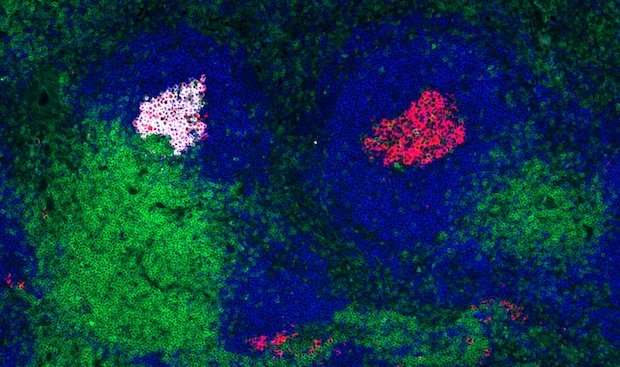Study establishes benchmarks for HIV vaccine candidates

The development of a vaccine that protects against HIV infections has proven extraordinarily difficult. One of the reasons is that naïve precursor B cells that can give rise to mature B cells producing broadly neutralizing antibodies—a requirement for a successful antibody-based HIV vaccine—are considered to be exceedingly rare within the average human.
Publishing in the December 26, 2017, online issue of the journal Immunity, researchers at the La Jolla Institute for Allergy and Immunology (LJI) now show that despite their low frequency these B cell precursors can be successfully primed to prevail over their B cell competitors under the right conditions.
"We had shown in an earlier study that we can find these B cells in most humans but at a very low cell frequency, about one in a million. What we didn't know was whether that was enough cells to elicit an effective immune response," says senior author Shane Crotty, Ph.D., a professor in LJI's Division of Vaccine Discovery. "We had the numbers, but we didn't know what they actually meant." By providing an answer, the current study closes the knowledge gap about competition between different immune responses and establishes defined benchmarks vaccine candidates should be compared against for consideration before they are put into clinical trials.
"As the vaccine field is getting much more sophisticated, we need to understand the requirements for good vaccine design so we can elicit the immune response we want as opposed to a competing one," explains postdoctoral researcher and first author Robert Abbott, Ph.D. "What we found is that when you reduce the precursor frequency to one in a million, the vaccine candidate's affinity becomes a distinct separating factor for competitive success of a B cell."
Germinal centers, specialized areas within lymph nodes, are the central arena where the competition for immunodominance plays out. Before B cells are able to produce neutralizing antibodies they have to persevere in a competitive, multi-step maturation process that selectively promotes the proliferation of B cells that produce antibodies that bind the best to the virus or other immune stimulant. B cells undergo a specialized process called affinity maturation in which they undergo successive rounds of mutation and selection ultimately resulting in increasingly better antiviral antibodies.
"B cells have to actually transform their normal DNA, in some instances quite substantially, to be able to effectively chase the virus over time" says Abbott. In the B cells that produce broadly neutralizing anti-HIV antibodies, meaning those that can bind to the many variants that occur rapidly in different individuals as the virus tries to evade the immune response, the level of mutation can be extraordinarily high, changing 30 to 50 % of the genes encoding them. It helps explain why it can take years before HIV-infected individuals start making these neutralizing antibodies. But it also presents a unique challenge for an HIV vaccine since conventional vaccination protocols are unlikely to generate enough of the desired mutations to enable protective antiviral immune response.
That led Scripps Research Institute professor and co-author William Schief, Ph.D., to conceive a sophisticated, multi-step protocol designed to shepherd B cells closer and closer toward producing broadly neutralizing antibody. The process is based on vaccinating with a series of gradually changing immunogens, which are the substances related to the virus used to elicit the immune response. The process is comparable to teaching a B cell that recognizes squares to bind to circles by using pentagons as an intermediate step.
The vaccination step studied by LJI researchers was the first or 'priming' step, which is designed to expand the pool of suitable precursor B cells. To assess the roles of immunogen affinity and precursor frequency during that first step, the team developed a mouse model that allowed them to recapitulate physiological human B cell frequencies. They were particularly interested in B cells that give rise to 'VRC01-class' antibodies, which are some of the best broadly neutralizing antibodies found in HIV-infected individuals.
"The idea here is to find shortcuts that focus on B cells that look the right way and teach them to go into the right direction," says Crotty. "After this step, immunized people won't have neutralizing antibodies but the idea is you get more of the B cells that could—after some other help and with additional immunizations— develop into B cells that produce neutralizing antibodies." It is a general vaccine strategy that has never been tested before in humans but given the right immunogen it can work, predicts Crotty.



















